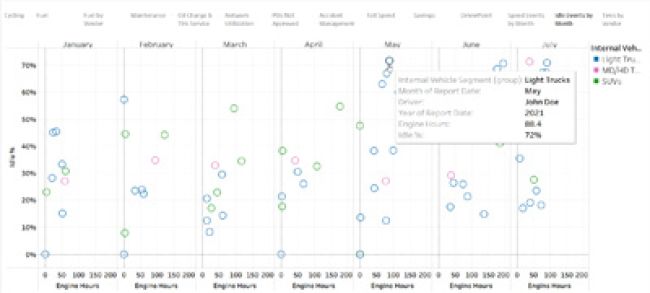
Top Trends to Watch in Fleet Technologies
As electric light-duty trucks and vans begin to be delivered to customers, fleet managers are keeping a close eye on emerging technologies that could reshape operations over the next year or two.
Battery-electric vehicles are some of the hottest tech to hit the market, especially for utilities that have committed to reducing their greenhouse gas emissions. But they’re in short supply, as are gas and diesel vehicles, due to the semiconductor shortages that have hampered vehicle production worldwide.
Another top trend is analyzing the billions of data points from connected vehicles to help guide not only fleet acquisition and rationalization but driver performance as well.
Electric Vehicles
The Rivian R1T is one of the first battery-electric pickups to go from prototype to production, with trucks hitting the streets late last year. The Ford F-150 Lightning is expected to roll off the assembly line this spring. The Tesla Cybertruck launch has been delayed, but don’t count Elon Musk out of the race just yet. And other manufacturers have announced or are already producing hybrid versions of pickups and SUVs to improve gas mileage and reduce environmental impact. Electric medium- and heavy-duty trucks are still a few years away from widespread availability.
Some fleet drivers could take home light-duty vehicles like a plug-in hybrid Prius or an F-150 Lightning pickup, but that could also present a challenge.
According to Jeremy Dewey, manager of EV operations for Holman Enterprises (www.holmanenterprises.com), a fleet management provider based in Mount Laurel, New Jersey, “You have to look at the infrastructure for charging – can the employee’s home accommodate the installation of a charging station?”
Dewey also said that overreliance on public charging infrastructure could be a dangerous and costly proposition as drivers may find it challenging to find a working charger where and when they need one.
The chip shortage won’t last forever, and when it eases, manufacturers will ramp up EV production, so it’s a good idea to prepare. Utilities should assess their EV readiness and replacement needs to support the company’s overall sustainability goals, said John Wuich, vice president of strategic consulting services for Donlen (www.donlen.com), a Bannockburn, Illinois-based fleet management company.
“Map out your charging infrastructure before your EVs hit the ground and keep an eye and an ear to federal tax credits and state and local rebates that may be available,” Wuich said.
Data Analytics
With a flood of data from fleet telematics, it’s easy to get caught in analysis paralysis. Fleet managers can track power-takeoff usage, unproductive idle time, route optimization, seat-belt usage and high-risk driving behavior, such as harsh braking and aggressive cornering.
It’s tempting to try to home in on the perfect solution for every problem, but that’s not realistic. Instead, Dewey recommended fleet managers use the data to make quick, actionable decisions.
“If you’re seeking perfection in the data, I would caution you against it; strive for ‘close enough’ and then work on incremental improvements from there,” he said.
Fleets need the right tools and analytics professionals to make the best use of the data they already have and will generate using EVs.
“The fact that most companies seem unable to identify an actual return on telematics investments or seem to use telematics as an asset tracker may be an indication that data is not being used to the full benefit,” Wuich said.
Fleet Utilization
Fleets can track assets to make actionable decisions to repair, replace or redeploy assets where needed. Assets that are overutilized tend to lead to higher maintenance costs. It may make sense to redeploy underutilized assets from elsewhere to reduce operational expenses. Given the rising costs in the used vehicle market, underutilized assets could be liquidated for a high return on value.
Fleets may also have surplus vehicles because their driver population has decreased due to the pandemic and other factors.
“With telematics, maintenance and other data, it’s a quick assessment to decide which vehicles to sell off and capitalize on that given the state of the U.S. vehicle market today,” Dewey said. “Suppose you have vehicles that are no longer necessary to support your business. In that case, there’s an opportunity to liquidate them for top dollar, money that can be reinvested into other areas of your business.”
Sustainability
Fleets are under pressure to commit to carbon emissions reduction and other sustainability measures in the coming years. It will take time to develop a strategy based on real-life data and a plan to adopt electric or alternative fuel vehicles to meet those goals. What once seemed like science fiction with EVs is rapidly becoming a reality.
“You have to start with a plan today because this is not an evolution, it’s a revolution,” Dewey said. “Identify your goals and determine the incremental steps it will take to achieve those goals over the next three, five, 10 years. Transitioning to EVs and hybrids won’t happen overnight, so it is best to plan for a gradual transition over the course of multiple vehicle life cycles.”
A utility’s ability to meet its goals is dependent on how well its fleet transitions from gas or diesel to EVs.
“The key will be good replacement forecast planning, so setting a goal now gives you a target at which to shoot as you plan your transition,” Wuich said.
About the Author: Gary L. Wollenhaupt is a Phoenix-based freelance writer who covers the transportation, energy and technology sectors for a variety of publications and companies.
*****
Prepare for the EV Transition
Industry experts recommend these steps to plan for your utility fleet’s transition to electric vehicles:
- Set sustainability goals.
- Assess current EV readiness.
- Forecast replacement needs.
- Understand EV availability.
- Map availability to needs.
- Assess total cost of ownership and carbon reduction relative to goals.
- Map out charging infrastructure.

